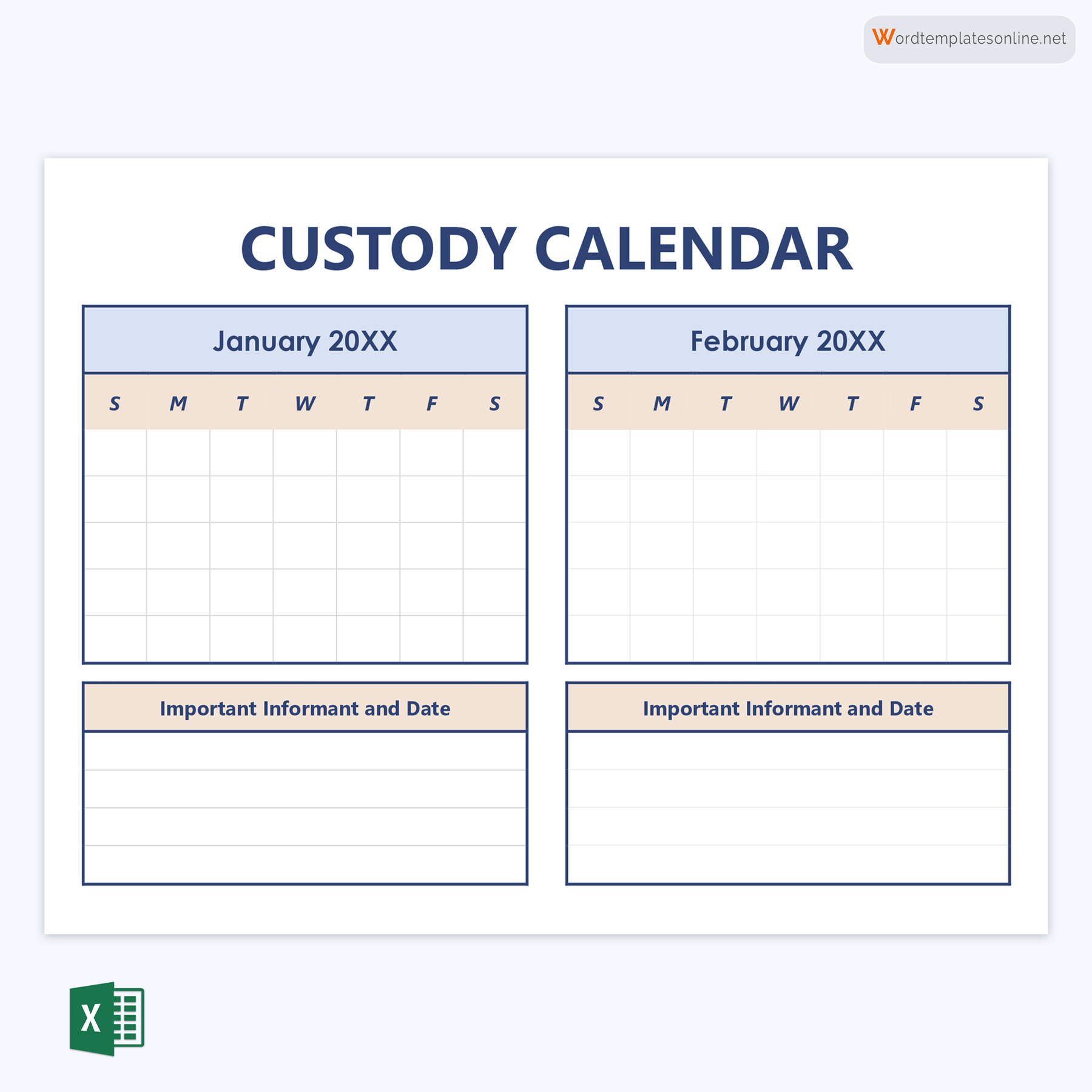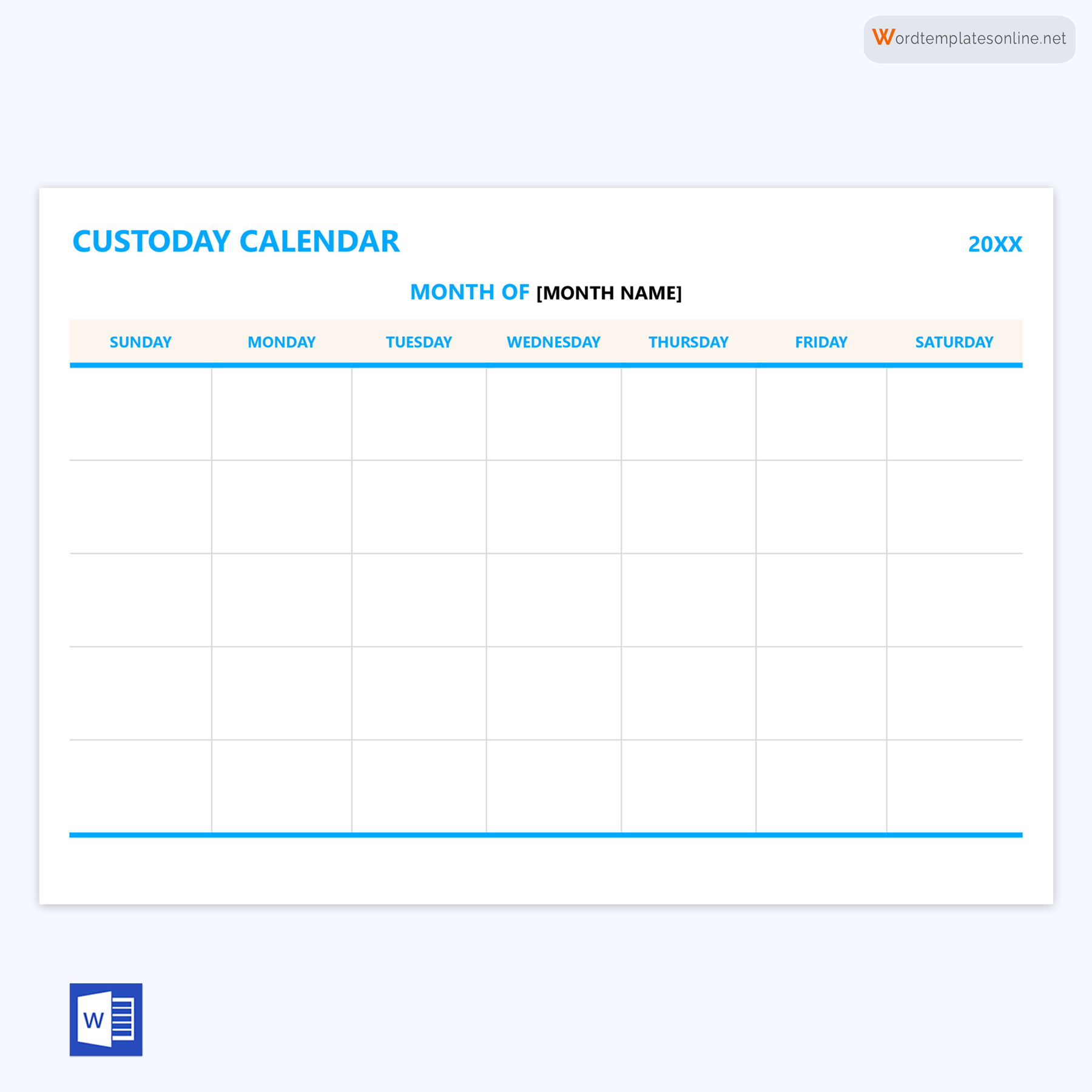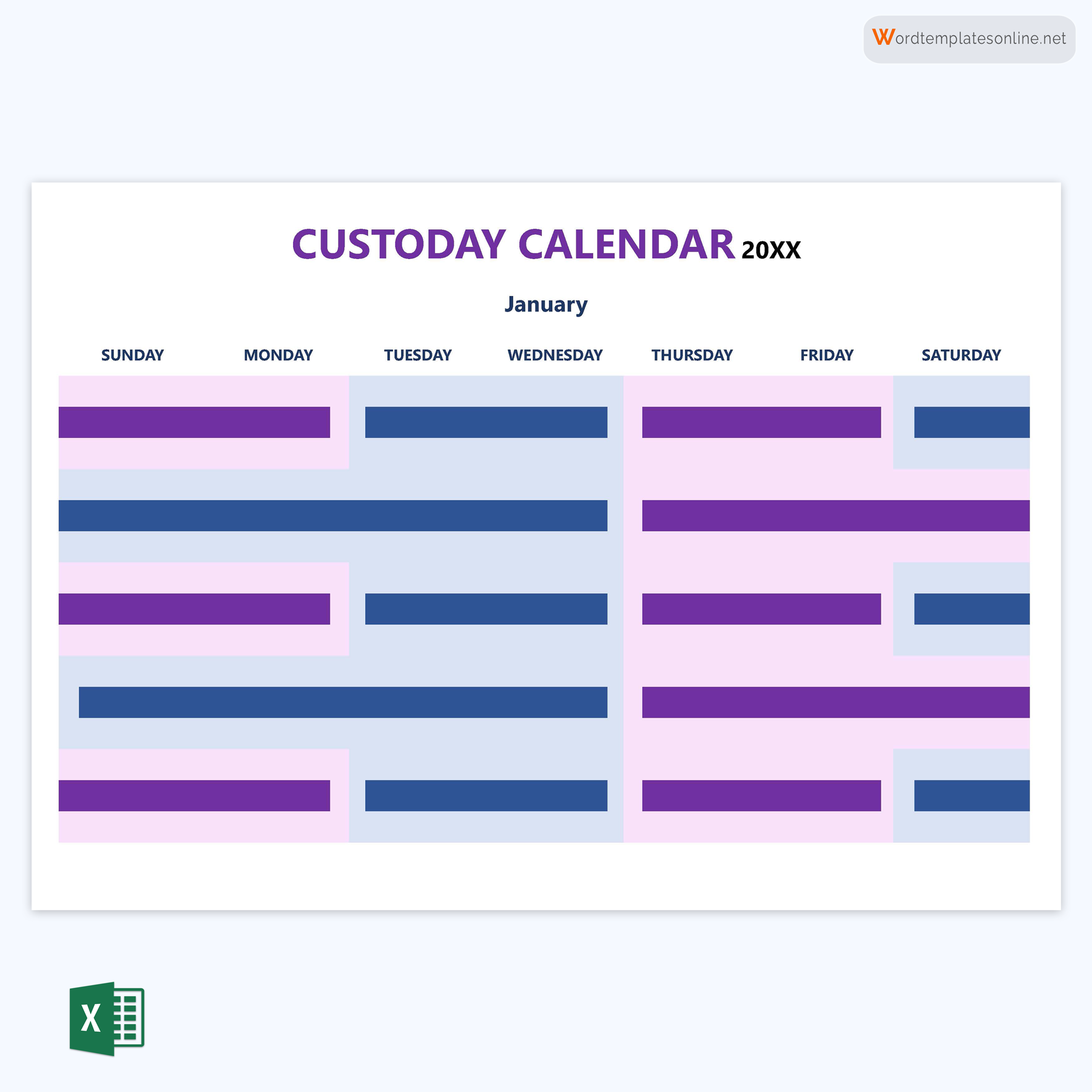A custody calendar is a structured document used by divorced, separated, or co-parenting individuals that outlines the days and times the child will spend with each parent.
Also known as a parenting plan, this document outlines the responsibilities of each parent towards the well-being of their child, helping minimize conflicts and maintain consistency. The calendar is usually included in a divorce or separation agreement and outlines the details of joint or shared custody arrangements. The ideal calendar is determined by the distance between each parent’s residences and establishing a clear plan for custody exchanges.
Your child’s emotional, physical, and social needs should be taken into consideration when developing the calendar. For this reason, we will address the need for the schedule and key elements of a template for a custody calendar in this article. For your convenience, a step-by-step guide for drafting the calendar has also been provided, along with free templates in MS Excel format.
Custody Calendar Schedules
You can adopt different custody schedules depending on your child’s needs and requirements. The most straightforward schedule is the 50/50 custody and visitation schedule, which includes alternating weeks or days. In this arrangement, the child spends one or two weeks with one parent and the following week or weeks with the other, providing extended periods of uninterrupted time and consistency in both households.
The 50/50 schedule may also include the 3-4-4-3 plan, where the child spends three days a week with one parent and four days with the other and vice versa. It may also take a 2-2-5-5 format, which alternates weekends and two weekdays with each parent, or a 2-2-3 schedule, where the child spends two days with one parent, two with the other, and three days with the first parent.
With a 60/40 custody schedule, one parent stays with the child during the week, whereas the other parent enjoys long weekends with the child. It may also include the 4-3 plan, where the child spends four days with one parent followed by three days with the other.
A 70/30 custody schedule may include a 5-2 plan where the child spends five days with one parent and two days with the other parent. In this plan, the child rotates between parents every three days or every third week, i.e., the child spends two weeks with one parent and one week with the other.
Finally, the 80/20 custody schedule incorporates alternating weekends. With this schedule, the non-custodial parent spends the first/third/fifth, or second/fourth/fifth weekend with the child. The child may also spend every third weekend with the other parent. For parents who live far apart, the child may spend summer breaks with the non-custodial parent or visitation times with other third parties such as grandparents or other relatives.
Free Custody Calendar Template








What is a Custody Calendar Template?
A custody calendar template is a pre-designed paper or digital file that helps you develop efficient custody and visiting arrangements for your child.
It is a blank or partially filled-in calendar format you can use to specify when your child will spend time with each parent during weekdays, weekends, and holidays. It outlines the visitation periods, custody schedules, and other pertinent details related to your child’s requirements.
A template provides you and your co-parent with a comprehensive view of your custody and visitation arrangements over a long period. It is a useful resource if you wish to set clear and consistent joint or shared custody arrangements without beginning from scratch. It may also be presented in various formats, such as electronically or in print, to ensure you and your co-parent can manage your parental obligations efficiently.
Understanding the Need for a Custody Calendar Template
If you need to create a custody calendar, especially for court approval, using a template may be the most practical way to do so. Discussed below are the benefits of using a template for a custody calendar:
- A template gives you a well-structured framework for organizing custody and visitation times, as well as other crucial arrangements. It helps you explicitly define when each parent will have custody of the child, reducing uncertainty and potential misunderstandings. It also helps ensure both of you are aware of your respective responsibilities, creating a stable and healthy environment for your child.
- The use of a template promotes clarity in custody arrangements. An unambiguous routine can minimize miscommunication and misunderstandings. Both you and your co-parent can easily refer to the calendar to confirm schedules, reducing the likelihood of disagreements and ensuring you both are on the same page about the custody arrangements.
- If a court handles the divorce or separation, legal documentation of custody arrangements may be required. Using a template can help you draft a custody calendar highlighting the agreed-upon schedule, showcasing your commitment to the safety and well-being of your child. This helps promote consistency in custody arrangements. Furthermore, legal documentation can serve as tangible evidence during legal proceedings, when a judge may consider granting full custody to one parent.
- Both you and your co-parent can focus on your child’s needs and well-being by using a template to create a custody calendar. It fosters joint decision-making, encouraging a stronger co-parenting relationship. A personalized schedule tailored to your child’s unique requirements promotes a sense of responsibility and autonomy.
Key Elements of a Custody Calendar Template
Most parents want to spend as much time as possible with their children while failing to account for the fact that their child has other commitments, such as school and extracurricular activities. This may not affect the overall structure of the template but may often change the manner in which a child needs to be cared for.
Your child should be treated fairly during the joint or shared custody process, and as such, the template should contain the following crucial elements:
Regular visitation time
The template has a section to outline regular visitation times clearly. It allows you to specify the routine schedule when your child transitions between you and your co-parent’s households during weekdays and weekends. For divorce or separation agreements where only one co-parent is granted visitation, the days they get to see the child may be predetermined, or it may require a discussion about how these visitations will be scheduled.
This section may also include additional details such as drop-off and pick-up times to establish a predictable routine for your child. This helps minimize disruptions in the child’s routine and fosters stability. The arrangement may vary over time and may need to be revised if it no longer offers either of you equal parenting time.
Holidays
The template allows for holidays to be incorporated into the calendar, in which the child spends major time with different parents on alternate years, a rotating schedule, or a combination of the two. In some cases, you may split a holiday, allowing your child to spend part of the day with you and the remainder with your co-parent. In this section, you may also outline whether there will be any make-up time if a holiday falls on the non-custodial parent’s regular custody day. This allows the other parent to spend enough time with the child on another date to compensate.
School breaks
Long school breaks such as summer vacations, winter breaks, and spring breaks are included in this section of the template. You can specify how these periods will be allocated between you and your co-parent. For instance, you may have your child during winter break during odd-numbered years, while your co-parent has custody during even-numbered years. Incorporating school breaks into your calendar helps you plan in advance and ensure your child has a consistent and stable routine during these extended periods of time off from school.
Special events or occasions
Events and occasions such as birthdays, weddings, family reunions, or religious observances may hold some emotional significance for your child. This section of the template allows you to outline how these events will be celebrated. You may also specify which parent can access the child during these events. In some cases, this might require modifications to the regular calendar to accommodate the event. Outlining how special events will be celebrated ensures your child can enjoy these moments fully without any uncertainty.
important
“Shared” and “joint” custody are terms commonly used in the context of child custody arrangements after separation or divorce. While they may be used interchangeably, they have different connotations and legal implications. For shared custody, both parents have roughly equal amounts of shared responsibility and parenting time with the child. The child spends significant time living with each parent, such as alternating weeks, weekdays, or weekends. Shared custody aims to maintain a meaningful and balanced relationship between both parents and the child. Joint custody, on the other hand, mainly focuses on decision-making rather than physical custody. In this parenting arrangement, both parents share responsibility for significant decisions about the child’s development, such as healthcare, education, religion, and extracurricular activities. Even if the child primarily resides with one parent, a joint custody arrangement ensures both parents are involved in the decision-making process.
When drafting a custody calendar following a divorce or separation, open and effective communication is crucial. Furthermore, unforeseen circumstances may arise, and as such, the calendar has to be as flexible as possible. An effective calendar is critical to your child’s well-being and stability. Therefore, proper communication and flexibility are critical when developing a successful and workable plan. This allows you to make decisions that prioritize your child’s needs, preferences, & routines and, helps minimize misunderstandings & promotes harmony during your co-parenting journey.
Crafting Your Custody Calendar Using a Template: A Step-by-Step Guide
When drafting a custody calendar, it is important to include as many details as possible so that your co-parent knows how to respond in various situations. Below is a step-by-step guide to help you draft an effective calendar using a template:
Choose the right format
The first step in creating the calendar is selecting a suitable format. You may opt for a physical calendar you can easily access or a digital one, such as a shared online calendar or co-parenting mobile application. Even though a digital format allows for collaboration, a printed calendar is easier to use and more convenient.
Determine your needs
Next, determine which custody arrangement works best for both of you. Consider how regular visitation schedules, holidays, school breaks, and special events will be split between you and your co-parent. You may also consider all relevant dates and periods that must be included in your calendar. This will allow you to make a template that caters to your specific co-parenting situation.
Collaborative setup
Effective co-parenting necessitates ongoing communication. Ensure your co-parent has access to the calendar, and consider engaging your child in the conversation. Although younger children may not comprehend the topic of divorce and separation, older children, such as teenagers, are more likely to express their preferences. A collaborative approach ensures your child benefits from a healthy co-parenting relationship.
Define communication guidelines
When using a template to draft the custody calendar, remember to specify communication guidelines. Outline how you will discuss concerns or share updates, changes, and any additional information. Specifying a mode of communication, such as using an online platform, can help set clear expectations and prevent misunderstandings. You can centralize communication by deciding where talks will occur, which may be useful in court if an issue arises.
Factor in flexibility
Flexibility is paramount when developing the custody calendar. A flexible calendar allows you to respond to emergencies, work commitments, health issues, or any other unexpected changes without adversely disrupting your child’s routine. Specify how you will manage such scenarios in the calendar. A flexible calendar helps your child adapt quickly to changing circumstances without causing additional stress.
Add notes and comments
Leave a blank section to include notes or remarks about your custody arrangements. These can include transportation details, contact information, or any special instructions. Including notes or comments gives the calendar additional context, minimizing the likelihood of confusion.
Regularly update and review
If your joint or shared custody arrangement is court-ordered or involves significant legal issues, consider having a qualified family law attorney evaluate the calendar to ensure it complies with set legal requirements. Once finished, thoroughly review it with your co-parent to ensure you are on the same page. As your child grows, update the calendar regularly to ensure it captures your changing circumstances.
Conclusion
A custody calendar is a valuable tool that helps you and your co-parent navigate the complicated side of joint or shared child custody. It helps you establish order and predictability in your child’s routine during a period of significant change and transition. The calendar establishes a clear and agreed-upon structure for sharing parenting responsibilities, eliminating the likelihood of disagreements. It represents your readiness to collaborate so that your child can have a stable and healthy upbringing while having equal access to both parents.
As explored in this article, using a template streamlines the process of creating a custody calendar. It provides a structured framework for efficiently planning and managing parenting responsibilities while also encouraging cooperation between you and your co-parent. It has sections outlining regular visitation schedules and which parent spends holidays, school breaks, and special occasions with your child. Choose from our comprehensive collection of free downloadable calendar templates and fill out the necessary details.

